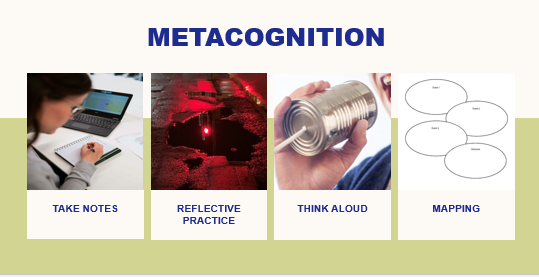Metacognition is simply stated as an awareness of how one thinks, or the ability to understand one’s thought processes. Basically, it is a self-awareness, being perceptive of one’s thinking processes.

So what? Why is this important?
It is important so that individuals feel empowered and more in control of their experiences, their thoughts, their learning. They become the master of their learning experiences. Gaining an understanding of their learning allows individuals to be proactive with their learning instead of reactive or dependent upon another to instruct, guide and regurgitate information. Understanding one’s thought processes enables additional learning and opens doors for continuous improvement while embedding information and deeply understanding knowledge to build upon for future learning opportunities. This leads to self-directed learning and what could be more powerful than knowing how to learn instead of depending upon someone else?
Within metacognition there are three different aspects to consider:
- Metacognitive experiences – Experience that encourage and develop metacognitive strategies
- Metacognitive strategies – determining the appropriate strategy and gaining a repertoire of strategies to use in learning
- Metacognitive knowledge – the actual use of metacognitive strategies and monitoring the learning process
Developing Metacognitive Strategies
When looking at how to develop these metacognitive strategies, start with a reflective practice. Pay attention to when and how the individual learns best. Ask basic questions:
Do I learn best in the morning? Evening? Afternoon?
Do I learn best by reading? Watching? Doing?
Do I learn best with more light? Less light?
There are many questions to examine when determining best learning options. Try looking at Dunn & Dunn Learning Style for some guiding questions and information.
Other ways to develop a better understanding of how you learn would be organize your thoughts. Spend some time looking at how you are making connections between old and new information. Graphic organizers can be most helpful in this endeavor.
Also, keep notes. Take notes. Try Cornell notes. This gives the opportunity and space to go back over your notes and make those needed connections.
Encourage a reflective practice. There are many options for reflective practice from a guided problem-solving methodology to application options.
Think aloud. Share what you’re learning with yourself and others. This also goes along with using as many senses as possible.
Try replaying what you’ve learned. Ponder through the experience. Try to recall as many details and facts as possible.
Do some mapping. This is a fun activity. Write down what you’ve learned. Scribble down other items, theories and facts that come to mind. Draw connections between the different items – like webbing. Make some notes as to why you think they connect and the connections you see.

Comments are closed